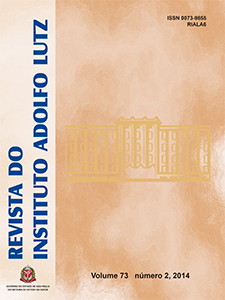Abstract
In this paper the electronic spreadsheets built in Microsoft ExcelR software are presented, and these parameters enable to estimate the decision limit (CCα) and the detection capability (CCβ) at the detection limit and of the maximum permitted value (MVP) regions. The estimates are evaluated from linear and homoscedastic analytical curves obtained in calibration procedures based on ISO standards and IUPAC guidelines. After validating by means of manual data processing, the electronic spreadsheets were used for determining the nitrite in bottled waters (MVP = 0.02 mg/L) and the fluoride contents in public supply waters (compliance interval = 0.6 to 0.8 mg/L). For fluoride analysis there are the minimum required value (0.6 mg/L) and the maximum acceptable value (0.8 mg/L) for its concentration; therefore, the spreadsheet computes the critical concentration at both limits with a probability of a type I error equal to 0.05. On that account, the electronic spreadsheets provide the rapid decision between compliant and non-compliant data in the interpretation of results.References
1. Currie LA. Nomenclature in evaluation of analytical methods including detection and quantification capabilities. Pure Appl Chem.1995;67(10):1699-1723.
2. Commission E. Commission Decision of 12 August 2002 implemeting Council Directive 96/23/EC concerning the performance of analytical methods and the interpretation of results. Off J Eur Comm. 2002;L221:8-36.
3. International Organization for Standardization - ISO. Capability of detection. 1997:ISO 11843-1,2.
4. Instituto Nacional de Metrologia, Qualidade e Tecnologia - INMETRO. DOQ-CGCRE-8: Orientação sobre validação de métodos analíticos - Revisão 04. 2011; 19 p. Disponível em: [http://www.inmetro.gov.br/sidoq/arquivos/Cgcre/DOQ/DOQ-Cgcre-8_04.pdf].
5. Thompson M, Ellison S, Wood R. Harmonized guidelines for single-laboratory vallidation of methods of analysis. Pure Appl Chem.2002;74(5):835-55.
6. Brasil. Ministério da Agricultura, Pecuária e Abastecimento. Instrução Normativa nº 24, de 14 de julho de 2009. Define os requisitos e critérios específicos para funcionamento dos Laboratórios de Análises de Resíduos e Contaminantes em Alimentos Integrantes da Rede Nacional de Laboratórios Agropecuários. Diário Oficial [da] República Federativa do Brasil. Brasília, DF, 22 jul. 2009. Seção 1, p. 7-15.
7. Brasil. Ministério da Saúde. Resolução RDC nº 274, de 22 de setembro de 2005. Aprova o “Regulamento técnico para águas envasadas e gelo”. Diário Oficial [da] República Federativa do Brasil. Brasília, DF, 23 set. 2005. Seção 1, p. 376-377.
8. Secretaria de Estado da Saúde - SES/SP. Resolução SS-250, de 15 de agosto de 1995. Define teores de concentração do íon fluoreto nas águas para consumo humano, fornecidas por sistemas públicos de abastecimento. Diário Oficial do Estado. São Paulo, SP, 16 ago. 1995. Poder Executivo, Seção 1, p.11.
9. American Public Health Association - APHA, American Water Works Association - AWWA, Water Environment Federation - WEF. Standard Methods for the Examination of Water and Wastewater. 19th ed. Eaton Ad, Clesceri Ls, Greenberg Ae, editors. Washington DC: American Public Health Association, American Water Works Association, Water Environment Federation; 1995.
10. Instituto Adolfo Lutz (São Paulo - Brasil). Métodos físico-químicos para análise de alimentos: normas analíticas do Instituto Adolfo Lutz. 4a. ed. Brasília: Agência Nacional de Vigilância Sanitária; 2005. 1018 p p.
11. International Organization for Standardization - ISO. Linear calibration using reference materials. International Organization for Standardization. 1996:ISO 11095.
12. International Organization for Standardization - ISO. Water quality - Calibration and evaluation of analytical methods and estimation of performance characteristics. International Organization for Standardization. 1990:ISO 8466-1.
13. Danzer K, Currie LA. Guidelines for calibration in analytical chemistry. Part 1. Fundamentals and single component calibration. Pure Appl Chem.1998;70(4):993-1014.
14. Dovidauskas S, Okada IA, Sakuma AM, Duran MC, Oliveira CC. Emprego de planilhas eletrônicas, baseado nas normas ISO e recomendações IUPAC, em curvas analíticas da análise de água. Rev Inst Adolfo Lutz.2013;72(1):13-24.
15. Brasil. Ministério da Saúde. Formulário Nacional da Farmocopéia Brasileira. Revisão 02. 2a. ed. Brasília: ANVISA; 2012. 224 p.
16. Polonini HC, Santos FC, Vaz UP, Brandão MAF, Raposo NRB, Ferreira AO. Desenvolvimento e validação de método analítico para determinação do teor de sinvastatina em cápsulas magistrais. Quím Nova.2011;34(3):516-9.
17. Schmidt Jr E, Melchert WR, Rocha FRP. Sistemas de análise em fluxo polivalente para a determinação espectrofotométrica de fármacos. Quím Nova.2011;34(7):1205-10.

This work is licensed under a Creative Commons Attribution 4.0 International License.
Copyright (c) 2015 Instituto Adolfo Lutz Journal
